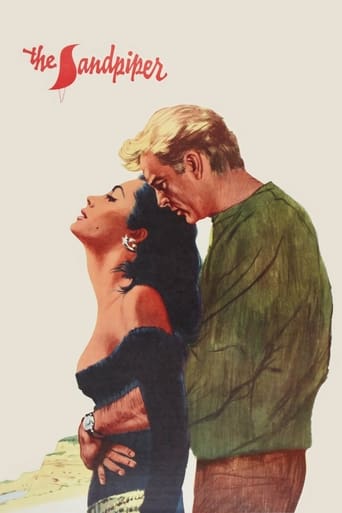Benedito Dias Rodrigues
I just remembering watching this movie in 1984,in that time gave 6/10 now in first time on DVD it refresh my mind on this fine picture,if was directed by the great Vincente Minnelli is worth to see itself,Taylor and Burton make a convincing performance in their roles,she as unmarried free woman with a son and he as Dr.Reverend who is school director,they get attracted each other ended up a dead end,he realize that your work is just a keeper of treasure's God when he raised funds to Church in fraudulent way making bad fiscal agreements to take the money,the conflicts existential driven him to start again in a new place alone...strong matters nowadays...Resume: First watch: 1984 / How many: 2 / Source: TV-DVD / Rating: 7.5
Bob-1914
The Sandpiper is interesting for its buffoonish take on the art and counter cultures of the 1960's. Taylor plays a struggling iconoclastic painter who somehow manages to live in the coolest place on earth, a designer home hanging off the cliffs of Big Sir with a view of the Pacific. Charles Bronson plays a beatnik sculptor, right. And they all hang out with a cool black guy artist, played by James Edwards. Burton is the Dr. Rev. Edward Hewitt, a cleric who falls in love with Taylors' breasts. The artwork sucks. The portrait of Taylor that the Bronson character sculpts is atrocious. She looks like she's straining on the toilet. The real artist, Edmund Kara, is a great sculptor but this piece is a mess. Taylor's endless paintings of the symbolic "sandpiper" also suck. They were painted by Elizabeth Duquette, the socialite wife of Tony Duquette, the great designer. They lack even rudimentary rendering ability; no sense of form, a mess of individual feathers that add up to neither a feeling of the whole nor a celebration of pattern, they're clumsy. Only a Hollywood moron with money would buy this junk. On the upside, the music is lush and the scenery sublime.
tieman64
One of director Vincente Minnelli's more interesting films, "The Sandpiper" stars Elizabeth Taylor as Laura Reynolds, a free-spirited mother who lives with her youngest son Danny. Laura – the film is very heavy-handed – is a full blown hippie. She's super liberated, is a single mom, atheist, home-schools her kid, lives on the beach, is a painter, promiscuous, hates social norms, her best friend is black and she hangs out with radicals. Oh, and she flaunts her boobs. Damn those beatniks.Mirrored to Laura is Dr Edward Hewitt (Richard Burton), the headmaster of an Episcopal boarding school. Edward is, of course, an ultra conservative. He's everything Laura isn't: rigid, a stickler for rules and regulations, an authoritarian, fundamentalist, traditionalist and stuck in a loveless marriage.Laura and Edward fall in love, but Laura's unconventionality and uninhibitedness disturbs Edward. He begins to have a crisis of faith. When the couple have sex one night, both fall apart. He questions the principles he's always held, she can't believe she's fallen for a man who represents everything she abhors. Realizing the hypocrisy of being a local authority figure who represents charity, religion and decency but takes bribes and bends to the whispers of women and money, Edward scuttles his job. He begins to spend more time with Laura. Maybe she can fix him. Big mistake. Edward's wife learns of the couple's liaisons and Edward is publicly shamed. He's pushed out of town. It's all very melodramatic.Look beyond the lust and you have one of Minnelli's more political films; a film about the political Left and Right recognising that, gee, maybe the Right should relax and the Left should appreciate a little discipline. The film's title refers to a bird which Laura heals and sets free. Laura teaches Edward as she heals this bird, the woman then releasing both into the wild. The film ends with Laura on a beach, Edward high above her on a hill. Symbolically the two positions they represent cannot meet or be reconciled. And so Edward stands on a rock, a mountain face epitomising his rigidity and spiritual arrogance. Laura sits below him, an outsider."The Sandpiper" oozes the era in which it was made. Only in this particular zeitgeist would you have a homosexual director making a politically charged beatnik flick which criticised catholic figureheads, was brazenly sexual, hinged on infidelity and featured Charles Bronson as a gypsy hippie. Minnelli's style is also wonderfully over the top. This is SUPER MELODRAMA, his direction deliberately operatic, campy, baroque and hyper stylised. It's the kind of film which uses crashing waves as a metaphor for sex and giant boobs as a symbol for all that is self-assured womanness. Everything's BIG BIG BIG. Voluptuous. Lurid. Modern audiences unaccustomed to this style have criticised Minnelli, but that was always part of his charm.Some of Minnelli's symbolism is subtle. Urban centres, houses and hard buildings are constantly clashed with more naturalistic, soft locales. This left/right paradigm informs most shots. And while the sandpiper and Edward are set free, Minnelli shows that both seek only to return to their own jails. Edward can't break free of his narrow world view, responds to meeting Laura by disappearing further into his marriage, further into church duties, and Laura is the same. Have they changed? Sure. Laura for the first time paints human beings in her paintings and Edward has started asking questions. But Minnelli is careful to show that conciliation leads only to social marginalisation and isolation. Ultimately, there is no progress here, only TOTAL, and FURTHER entrenchment. To change too much is too violent, there is no common future and the duo remain opposed. As with the majority of Minnelli's other films, it is song, dance and art which bridges opposites and helps bring people together, if only temporarily.8/10 – Worth one viewing.



